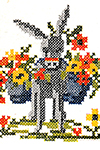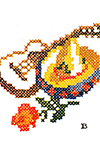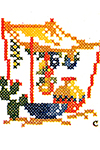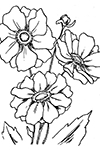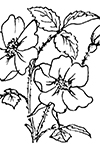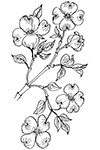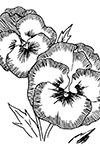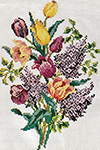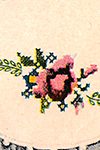Donkey Pattern

Pattern includes donkey motif A, 6 x 6⅜ inches; guitar motif B, 4¾ x 4⅝ inches; tent motif C, 4⅝ x 4⅝ inches and flower D, 1½ x 2¾ inches. A chart for placing the colors is also included in the pattern.
Mexican motifs give a gay and colorful air to table linens—and they are quite the vogue in decorative embroidery. As shown in the illustration, they are smart used on a lunch cloth, curtains and towels. The motifs are also suitable for lunch sets, runners, pillows, etc. The small flowers are for napkins. The design is entirely in cross-stitch and the crosses are 8 to the inch, suitable for six-strand cotton. The colors used for working are dark gray, light gray, dark green, light green, red, dark blue, light blue, yellow, orange, black, dark brown, light brown and purple.
HOW TO USE DESIGN—A 36, 45 or 54-inch lunch cloth trimmed with four motifs as illustrated is very effective. Two donkey motifs A, one guitar motif B and one tent motif C were used on the cloth. Motifs A are shown on the curtains and motifs B on the towels. A lunch set consisting of a centerpiece and four place mats would be very effective trimmed with these designs. The place mats, finished size 11 x 15 inches, may be trimmed with motifs B, placing one motif in the upper left hand corner of each mat. The centerpiece, 11 inches wide and the desired length, may be trimmed with motifs A, placing one at each end. Napkins trimmed with the small flowers D will complete the set. A 12 or 14-inch square pillow trimmed with motif A would be charming.
TO EMBROIDER—Follow the chart for placing the colors. Six-strand cotton—four strands in the needle—is used for the work. The entire design is worked in cross stitch. The most satisfactory results are obtained when the crosses touch as shown in the detail. Follow chart in the pattern for placing the colors.


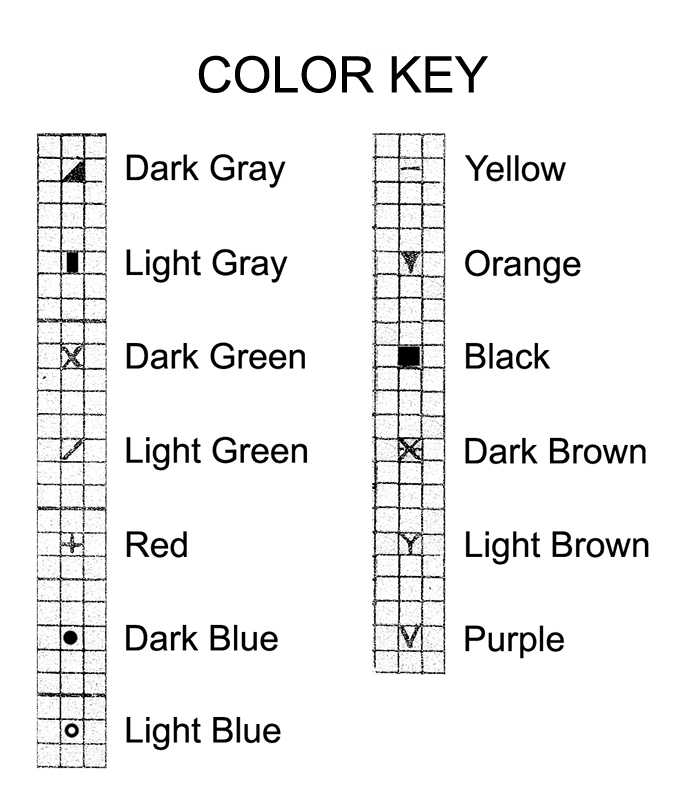
Mexican Motifs in Cross-Stitch | McCall's No. 891
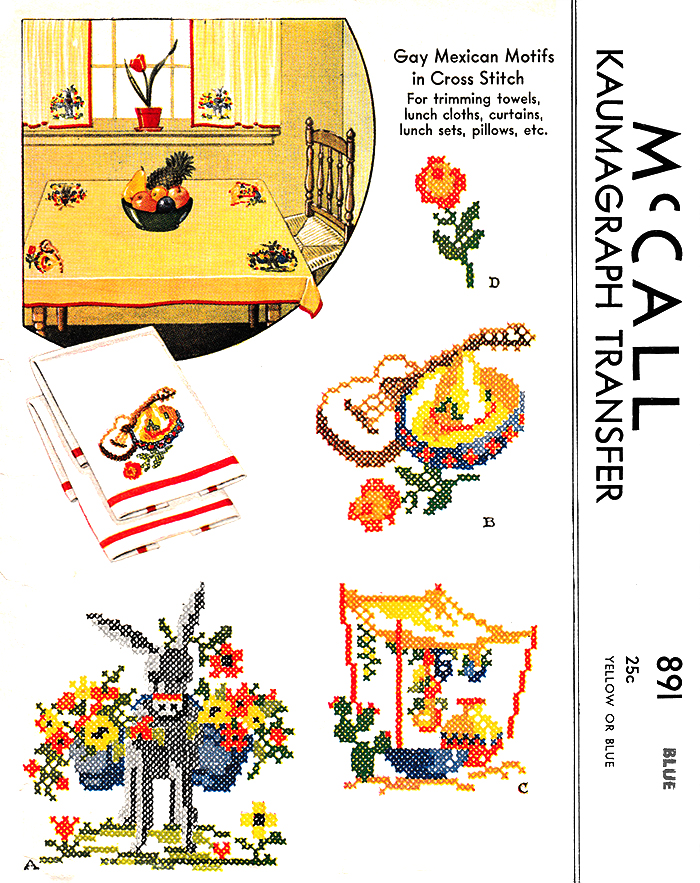
Mexican Motifs
Pattern 891
McCall's Pattern Company
Original Copyright 1941
Pattern includes donkey motif A, 6 x 6⅜ inches; guitar motif B, 4¾ x 4⅝ inches; tent motif C, 4⅝ x 4⅝ inches and flower D, 1½ x 2¾ inches. Mexican motifs in cross stitch are perfect for trimming towels, lunch cloths, curtains, lunch sets, and pillows.
Lilacs and Tulips in Cross-Stitch | McCall's No. 1397
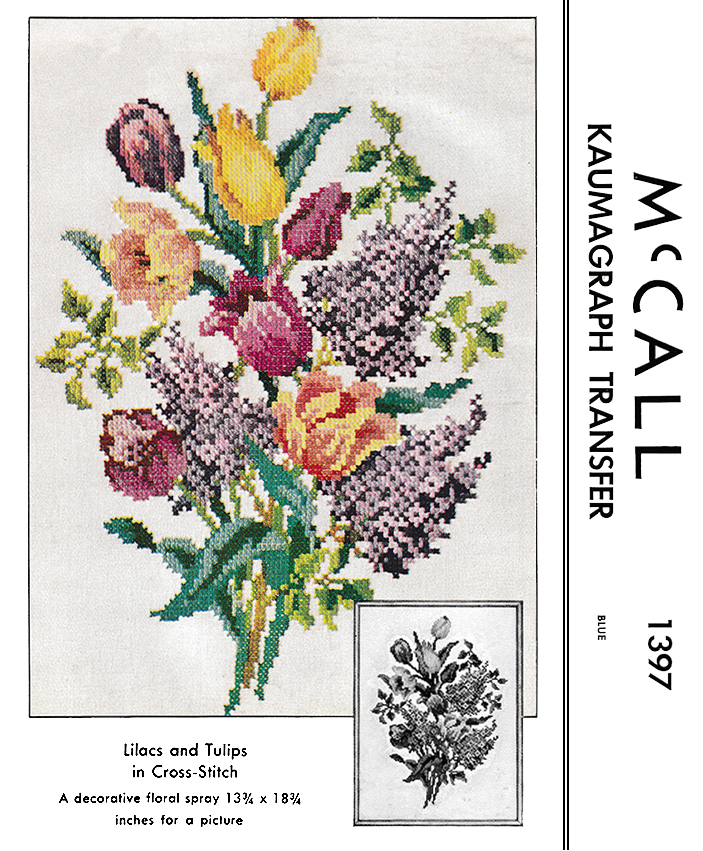
Lilacs and Tulips
Pattern 1397
McCall's Pattern Company
Original Copyright 1948
A decorative floral spray 13¾ x 18¾ inches for a picture.
MATERIALS REQUIRED—Six-strand embroidery cotton should be used for the work in the following colors and amounts. One skein each of light yellow, yellow, orange yellow, rust, peach, medium coral, deep coral, pale coral, bright rose, soft rose, rose, medium wine, dark wine, pink, light yellow green, gold brown and black and two skeins each of lavender, violet, deep violet, medium green, dark green, light blue green and blue green.
Flower #1 Chart Pattern
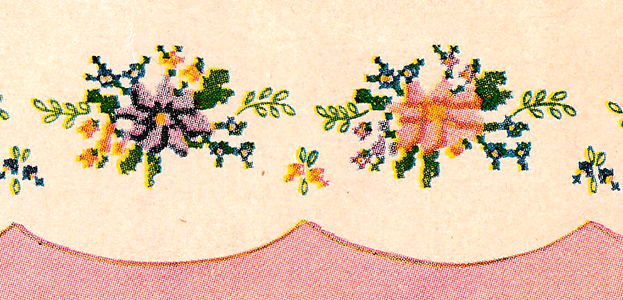
Pattern includes 2 designs A, 3¼ x 21 inches; 2 of B, 3⅛ x 21 inches; 2 of C, 3½ x 21 inches, and scallops for the back of each design. A chart for placing the colors is also included.
It's nice to vary plain linens with handmade sets, and with these designs, towels and pillow cases can be effectively trimmed. The edges may be finished with contrasting borders or with crochet. The designs are 21 inches wide and can be adapted to narrower or wider widths. To make the design narrower, cut it off evenly at both ends. To make it wider, extend the end scallops with a pencil. The crosses in the designs are 10 to the inch, suitable for six-strand cotton. The chart enclosed in the pattern lists the colors used in each design.
SUGGESTED MATERIALS—Plain linen or fine smooth huck toweling may be used for towels, and contrasting linen or cotton with a linen finish for the borders. Pillow case tubing is suggested for the pillow cases, and contrasting percale, gingham or chambray for the borders. If finishing edge with crochet, use No. 50 or 60 mercerized crochet cotton and steel crochet hook No. 11 or 12.
DESIGN FINISHED WITH CROCHETED EDGE—The illustration shows design C used a crocheted edge. Designs A and B may be finished in the same way, if desired.
CROCHETED BORDER—As a foundation for the crochet, run a row of fine machine stitching along the stamped line forming the scallops. Then run a second row of stitching as close as possible to the first row. Press stitching flat. Cut away material at outer edge, cutting ⅛ inch beyond the machine stitching. Work over the edge (covering the stitching) with single crochet, making a picot every half inch.
TO EMBROIDER—Six-strand cotton (four strands in the needle) should be used for the work. Follow the chart for placing the colors. The stitches are cross stitch and lazy daisy stitch. In working the cross stitch, be sure the crosses touch, as shown in the detail.

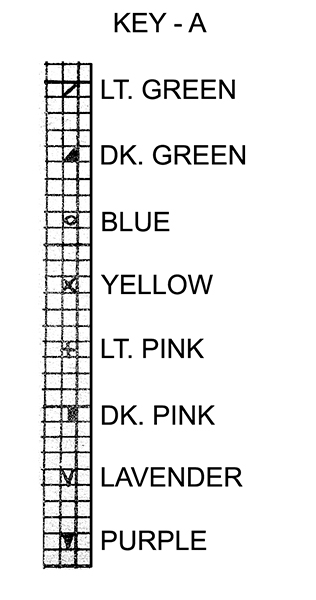
Flower #2 Chart Pattern
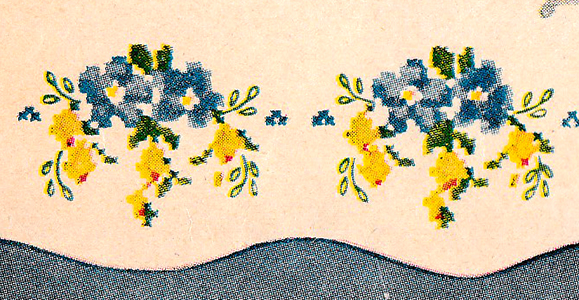
Pattern includes 2 designs A, 3¼ x 21 inches; 2 of B, 3⅛ x 21 inches; 2 of C, 3½ x 21 inches, and scallops for the back of each design. A chart for placing the colors is also included.
It's nice to vary plain linens with handmade sets, and with these designs, towels and pillow cases can be effectively trimmed. The edges may be finished with contrasting borders or with crochet. The designs are 21 inches wide and can be adapted to narrower or wider widths. To make the design narrower, cut it off evenly at both ends. To make it wider, extend the end scallops with a pencil. The crosses in the designs are 10 to the inch, suitable for six-strand cotton. The chart enclosed in the pattern lists the colors used in each design.
SUGGESTED MATERIALS—Plain linen or fine smooth huck toweling may be used for towels, and contrasting linen or cotton with a linen finish for the borders. Pillow case tubing is suggested for the pillow cases, and contrasting percale, gingham or chambray for the borders. If finishing edge with crochet, use No. 50 or 60 mercerized crochet cotton and steel crochet hook No. 11 or 12.
DESIGN FINISHED WITH CROCHETED EDGE—The illustration shows design C used a crocheted edge. Designs A and B may be finished in the same way, if desired.
CROCHETED BORDER—As a foundation for the crochet, run a row of fine machine stitching along the stamped line forming the scallops. Then run a second row of stitching as close as possible to the first row. Press stitching flat. Cut away material at outer edge, cutting ⅛ inch beyond the machine stitching. Work over the edge (covering the stitching) with single crochet, making a picot every half inch.
TO EMBROIDER—Six-strand cotton (four strands in the needle) should be used for the work. Follow the chart for placing the colors. The stitches are cross stitch and lazy daisy stitch. In working the cross stitch, be sure the crosses touch, as shown in the detail.
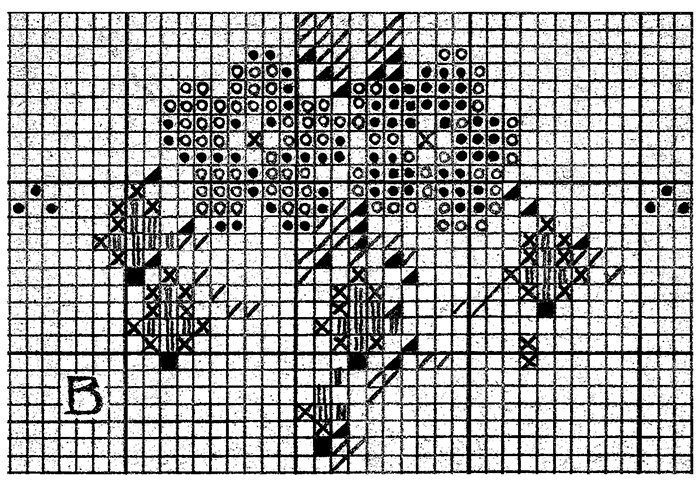
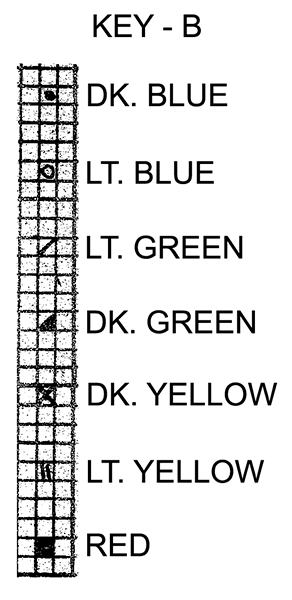
Flower #3 Chart Pattern
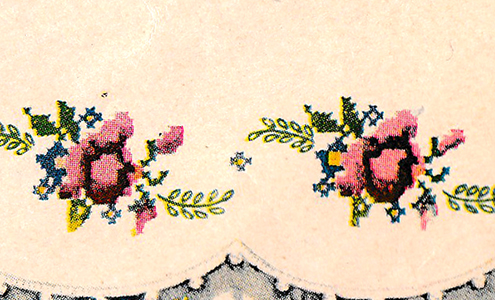
Pattern includes 2 designs A, 3¼ x 21 inches; 2 of B, 3⅛ x 21 inches; 2 of C, 3½ x 21 inches, and scallops for the back of each design. A chart for placing the colors is also included.
It's nice to vary plain linens with handmade sets, and with these designs, towels and pillow cases can be effectively trimmed. The edges may be finished with contrasting borders or with crochet. The designs are 21 inches wide and can be adapted to narrower or wider widths. To make the design narrower, cut it off evenly at both ends. To make it wider, extend the end scallops with a pencil. The crosses in the designs are 10 to the inch, suitable for six-strand cotton. The chart enclosed in the pattern lists the colors used in each design.
SUGGESTED MATERIALS—Plain linen or fine smooth huck toweling may be used for towels, and contrasting linen or cotton with a linen finish for the borders. Pillow case tubing is suggested for the pillow cases, and contrasting percale, gingham or chambray for the borders. If finishing edge with crochet, use No. 50 or 60 mercerized crochet cotton and steel crochet hook No. 11 or 12.
DESIGN FINISHED WITH CROCHETED EDGE—The illustration shows design C used a crocheted edge. Designs A and B may be finished in the same way, if desired.
CROCHETED BORDER—As a foundation for the crochet, run a row of fine machine stitching along the stamped line forming the scallops. Then run a second row of stitching as close as possible to the first row. Press stitching flat. Cut away material at outer edge, cutting ⅛ inch beyond the machine stitching. Work over the edge (covering the stitching) with single crochet, making a picot every half inch.
TO EMBROIDER—Six-strand cotton (four strands in the needle) should be used for the work. Follow the chart for placing the colors. The stitches are cross stitch and lazy daisy stitch. In working the cross stitch, be sure the crosses touch, as shown in the detail.
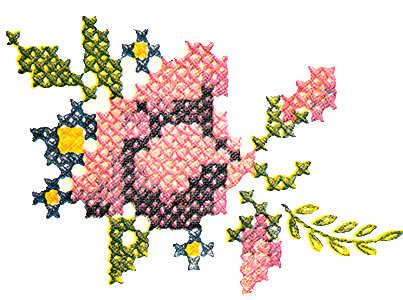
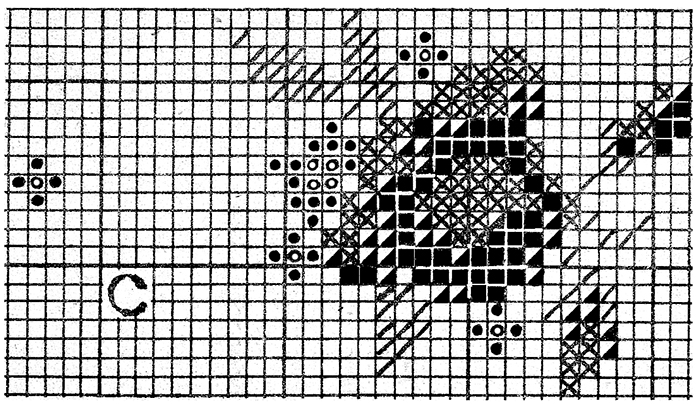

Floral Designs for Pillow Cases or Towels | McCall's No. 1025

Floral Designs for Pillow Cases or Towels
Pattern 1025
McCall's Pattern Company
Original Copyright 1942
Three cross-stitch designs for pillow cases or towels. Pattern includes 2 designs A, 3¼ x 21 inches; 2 of B, 3⅛ x 21 inches; 2 of C, 3½ x 21 inches, and scallops for the back of each design. A chart for placing the colors is also included.
SUGGESTED MATERIALS—Plain linen or fine smooth huck toweling may be used for towels, and contrasting linen or cotton with a linen finish for the borders. Pillow case tubing is suggested for the pillow cases, and contrasting percale, gingham or chambray for the borders. If finishing edge with crochet, use No. 50 or 60 mercerized crochet cotton and steel crochet hook No. 11 or 12.
Treasury of Pineapple Designs | Edited by Linda Macho
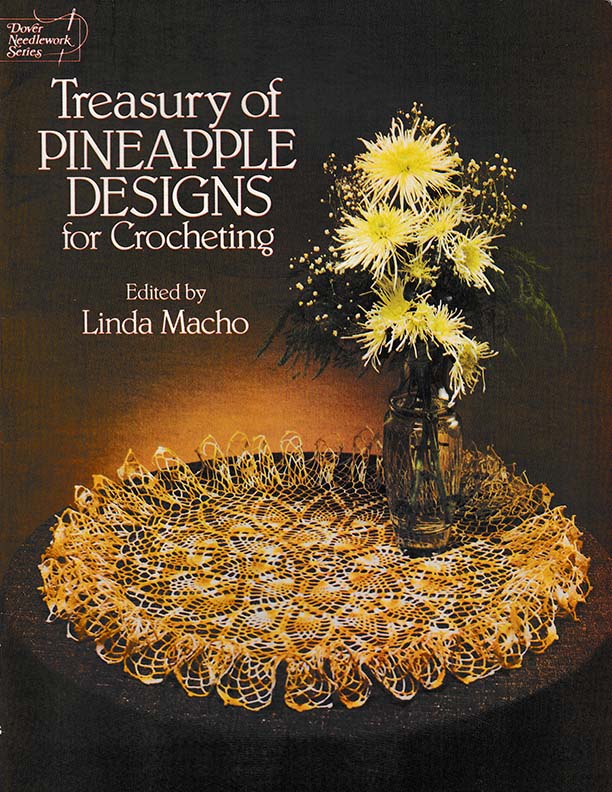
Paperback: 48 pages
Publisher: Dover Publications (May 1983)
Language: English
ISBN-10: 0486244946
ISBN-13: 978-0486244945
The pineapple has traditionally symbolized hospitality and good luck. Artists and craftsmen have turned that auspicious fruit into a popular design motif; none more so than crocheters, who have featured the pineapple in doilies, tablecloths, bedspreads and many other decorative items. By popular demand, here is a completely new volume of pineapple patterns, 32 elegant, enduringly fashionable designs from thread-company pamphlets published over 30 years ago. From this pineapple treasury, experienced and novice crocheters will find projects to challenge their skills.
All stitches used in this book are explained and diagrammed; general instructions, abbreviations, conversion charts for stitches and hooks and a Metric Conversion Chart supplement the patterns, each of which has step-by-step directions.
Traditional Edgings to Crochet | Edited by Rita Weiss

Paperback: 48 pages
Publisher: Dover Publications (November 2, 2011)
Language: English
ISBN-10: 0486252388
ISBN-13: 978-0486252384
For the enthusiastic crocheter who may not have the time to make tablecloths or bedspreads, crocheted edgings offer a popular and enduring alternative. With more than 130 patterns to choose from in this attractive collection, crocheters can personalize an item by simply adding a delicate, handmade finishing touch.
Assembled by noted needlework authority Rita Weiss, the selections in this volume have been reprinted from rare thread-company leaflets published in the 1940s and 50s. (Many of these instruction books - originally created to sell thread - are collector's items today.) Needleworkers will be delighted with the wide range of heirloom-quality patterns that include traditional filet crochet and filigree designs, as well as floral motifs incorporating such familiar blooms as the pansy, rose, forget-me-not, buttercup, and aster. Clear, step-by-step instructions make these patterns easy to work any where - in the home, at meetings or on public transportation.
Crocheters will want to use these lovely edgings again and again on a variety of personal and household items such as handkerchiefs, napkins, placemats, collars, cuffs, lingerie, pillowcases and much more.
| Pattern Categories Browse the categories to help you find the patterns you're looking for. |
||

